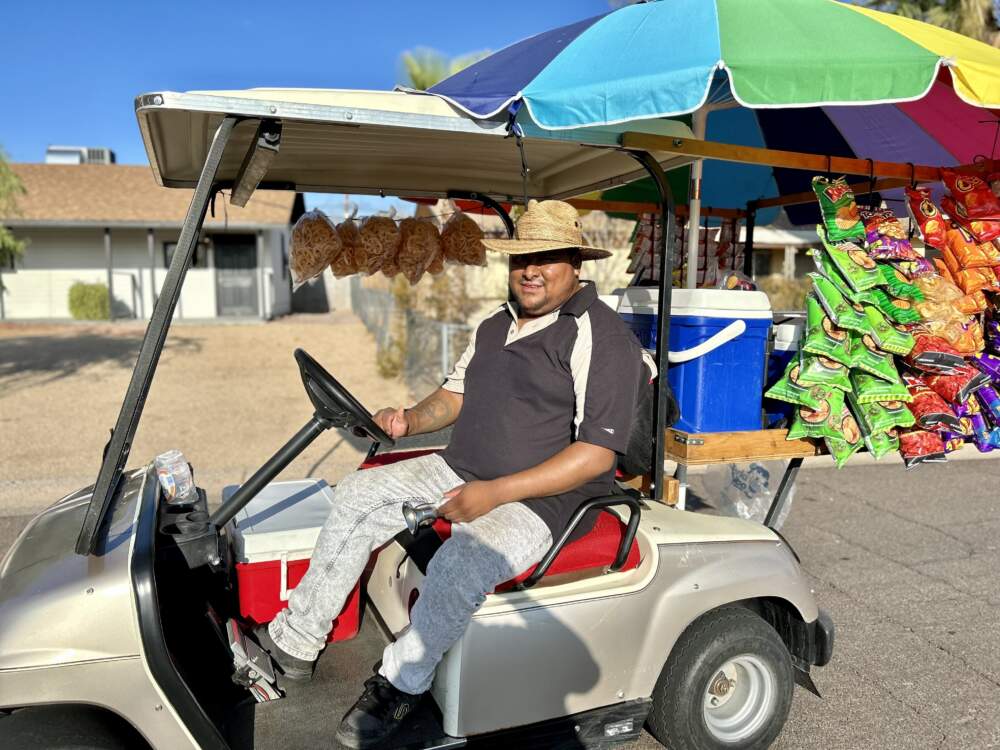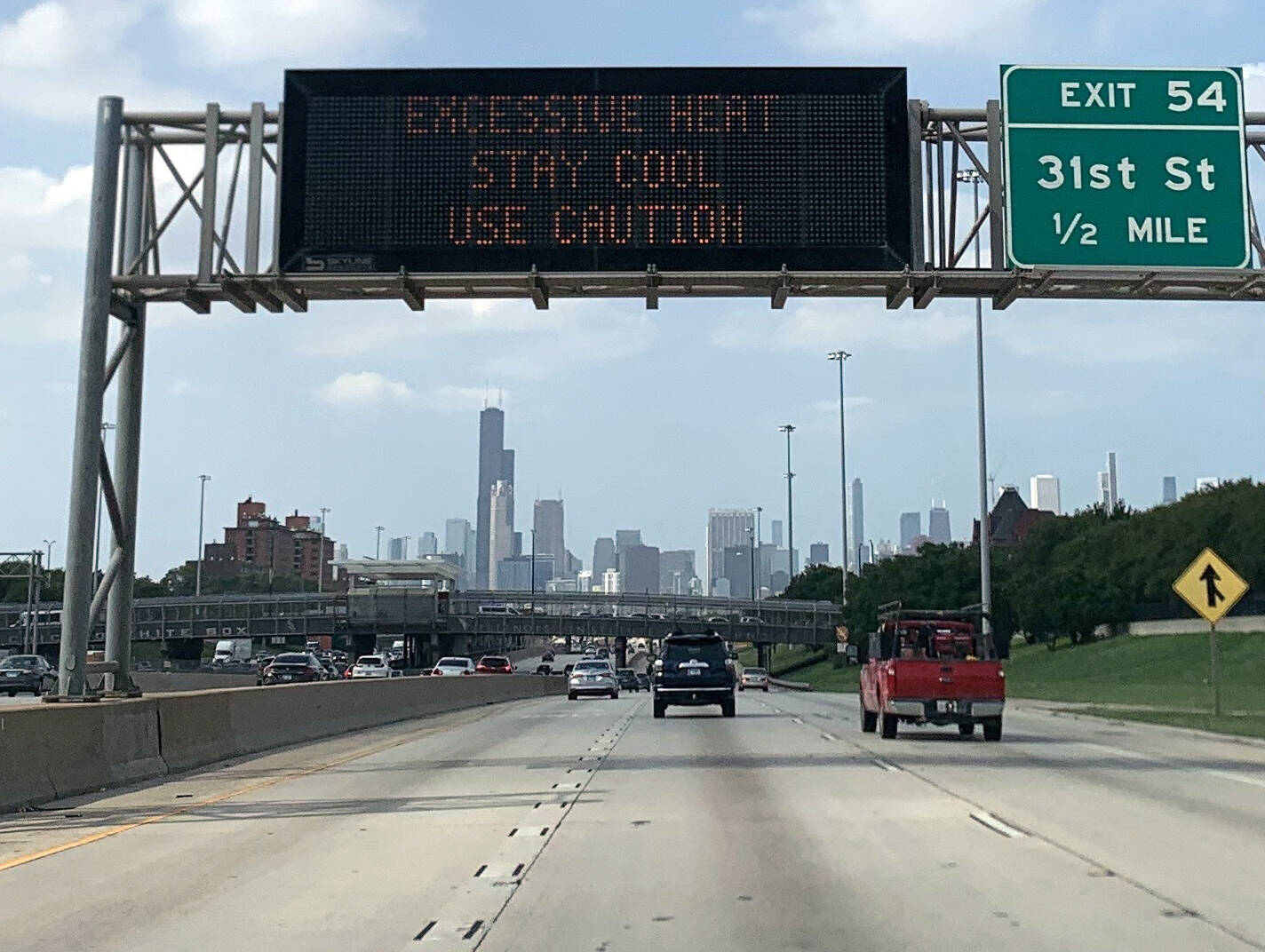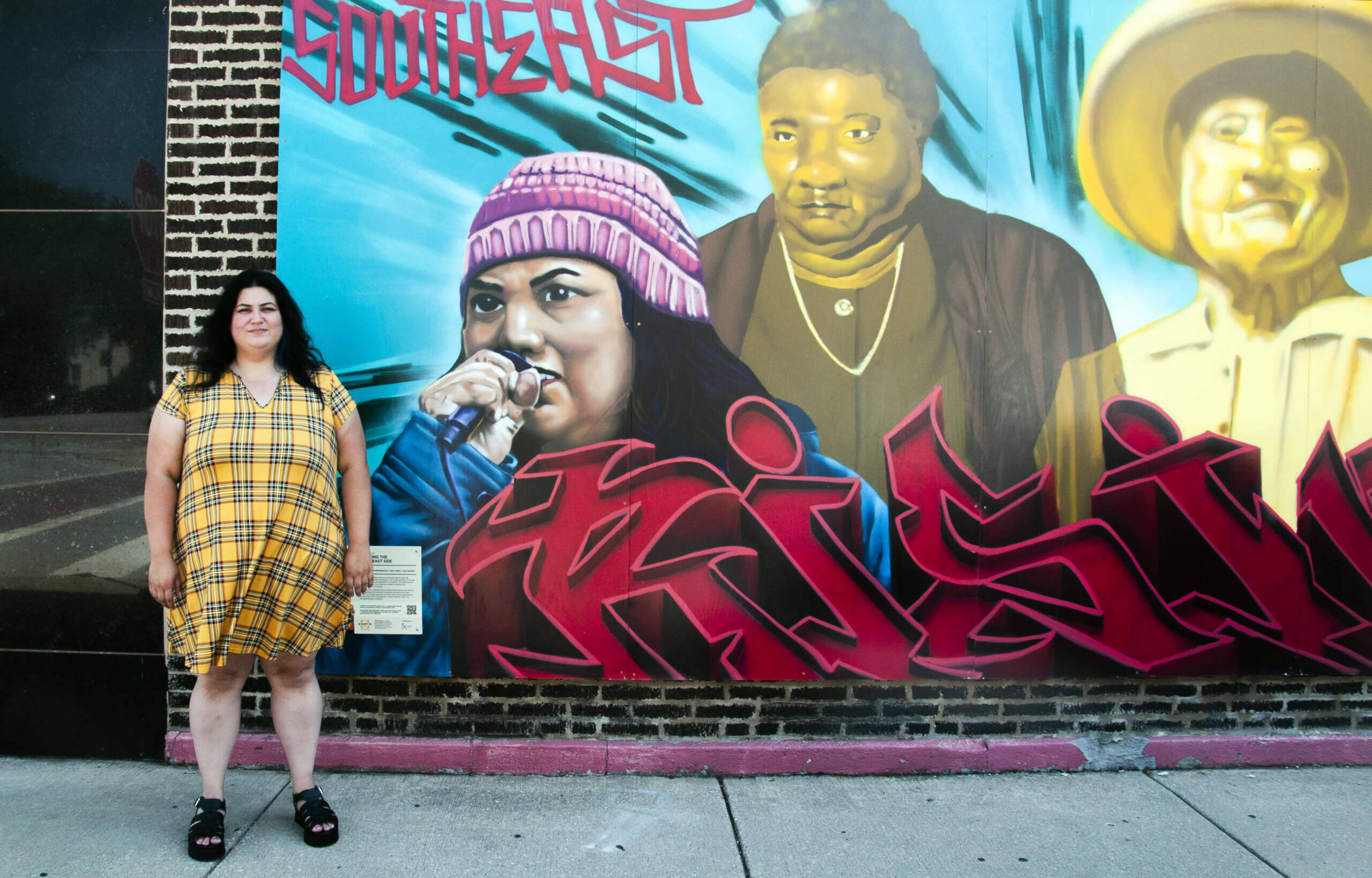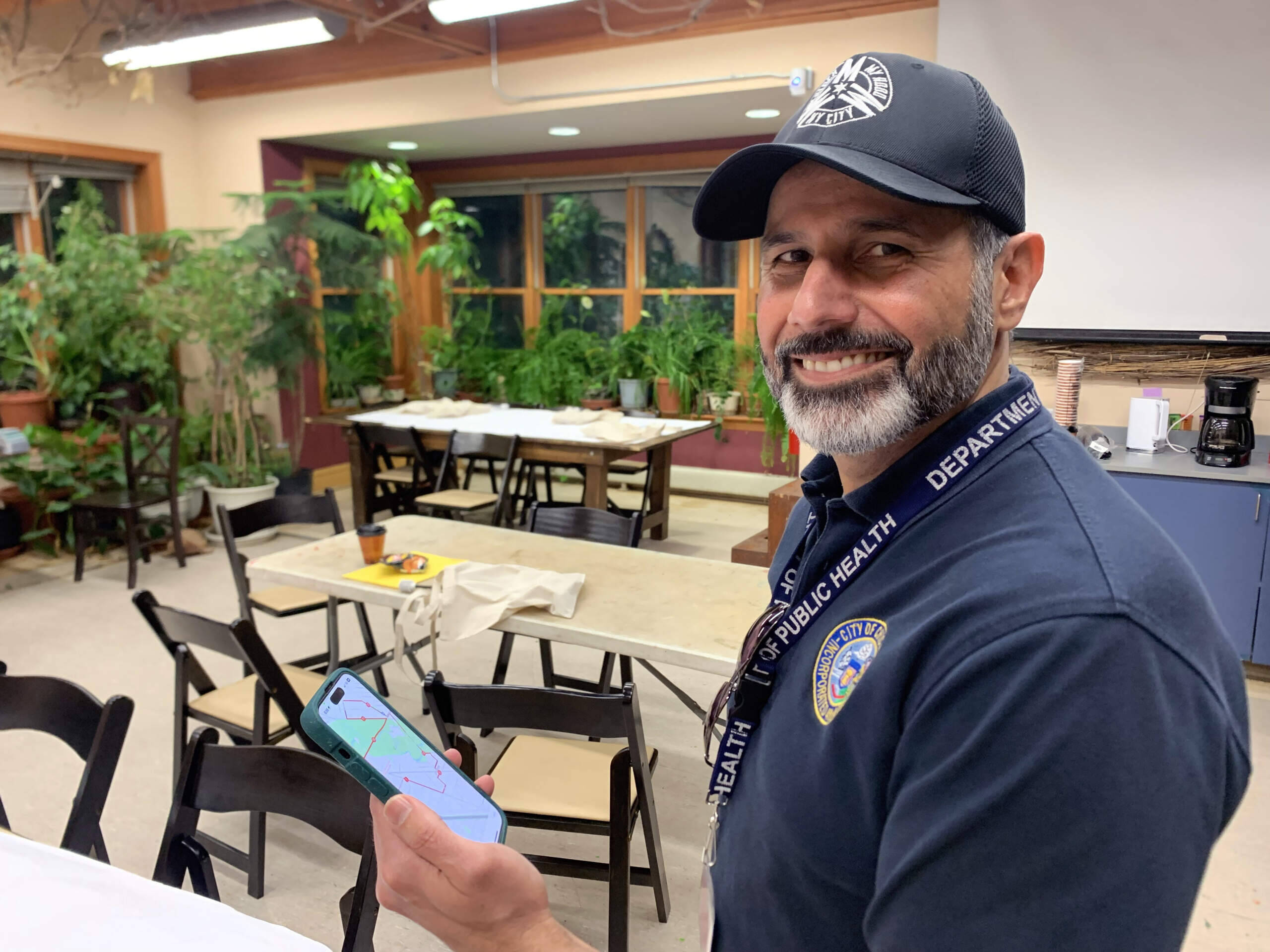Advertisement
As cities sizzle, mapping projects pinpoint the perils of hot neighborhoods
Resume
Intrepid street vendor Lauro Ilario drives a golf cart across the Phoenix asphalt for several hours a day selling cold drinks, snow cones and snacks to people he finds walking the streets.
But Phoenix just suffered through the hottest month ever recorded in an American city — and hardly anyone walks the street when it's 110 degrees outside. During the heat wave, Ilario says his sales fell to just $50 dollars when normally he'd make three times that. That's thousands of dollars of lost revenue at a time when electric bills are soaring.
Long before this heat descended on the state and made life miserable for people like Ilario, researchers began looking for ways to protect American cities from extreme temperatures. But first, they have to know exactly how hot it is. This summer the National Oceanic and Atmospheric Administration recruited citizen scientists in 14 states to help measure just how hot it’s getting. The data could help city officials and community groups address extreme heat in the neighborhoods that need it most.
Red hot asphalt
North of Phoenix, Americorp member Owen Kerslake is on a one-year assignment in the post-card perfect tourist mecca of Sedona. As the sun splashes its first rays of the day on the city's famous red rocks, Kerslake is busy attaching a temperature probe to the window of his car.
Since 2017, government scientists at NOAA have sponsored projects like this one to identify the hottest parts of more than 70 communities across the country.
At 6 a.m. sharp, Kerslake and his navigator Sean Smith will start driving a 9-mile route, recording a new temperature reading once every second. By the end of the day, he and a group of volunteers will have mapped the vast majority of the city.
“That's really the goal here, is to help the community adapt to these extreme heat events, which are becoming more frequent and intense with climate change,” Kerslake says. “Through that lens, this can be seen as a public health project.”
Sedona isn’t as hot as Phoenix, but logging heat data in the higher-elevated city helps scientists understand how hot weather affects the entire state, according to state climatologist ErinAnne Saffel.
“Everyone is familiar with Phoenix and how hot that gets in the center,” Saffel says. “But what happens is that every city and every town builds their own heat island.”
Even in Sedona, the asphalt streets and concrete buildings hold onto the day's heat long after the sun goes down, forming an urban heat island.
“I measured the asphalt last night, it was 145 degrees at 3 o'clock. I measured the sidewalk here it was 130 degrees. Those red rocks were 130 degrees,” she says. “The air temperature was 90, but those surfaces really build into that heat island.”
Extreme heat in the Midwest
Chicago is also among the 18 cities where volunteers are mapping the urban heat island this summer. Officials set up five hubs for dispatching volunteers to collect heat data on July 28, from a South Side Baptist Church to the offices of community groups like Mi Villita Neighbors.
They wanted to get a full picture of how vastly heat can vary across Chicago’s 234 square miles, and how much hotter some neighborhoods get than others.

Peggy Lambert showed up to the North Park Nature Center before 6 a.m. for her volunteer shift. She lived for eight years in Arizona and moved back to Chicago in part because of the heat.
“My last summer there it was 120 [degrees], like three days in a row,” she says. “I was like, ‘I need to move.’”
The day of the heat mapping project, it hit 90 degrees — not as hot as Phoenix but, Lambert points out, more humid. That meant a heat index of 105.
Oppressive humidity like that is one of the reasons that in 1995, a heat wave killed more than 700 people in Chicago. It got national attention and woke many cities up to the danger of extreme heat. The ’95 heat wave also exposed another grim reality: Inequality. The highest death toll was among Black residents in a handful of poorer neighborhoods.
That disparity prompted Stephany Spaulding to volunteer to record some temperatures in Hegewisch, an industrial corner of the city that sits on the border with Indiana.
“I hope that it translates into dollars,” she says. “Dollars that translate into infrastructure changes that expand the life expectancy of communities across the city equitably.”
‘Your house was like an oven’
Adella Bass shares that hope. She's a health equity organizer with the group People for Community Recovery. While dispatching volunteers like Spaulding, she thinks back to one of her earliest memories from the 1995 heat wave.

“I particularly remember how tragic it was, losing a lot of people,” she says. “Living in low-income neighborhoods, we didn't have air conditioning units. That next following summer is when my mom bought an air conditioner and made sure we had one in our room."
Bass carries lessons with her today from that experience. These days when it gets hot, she checks in on an elderly neighbor who doesn't have air conditioning. That's something she says the city could do, too.
“Just creating heat watch groups,” she says, “advocates to go door to door and check on those seniors who may not have that family member, that relative, that neighbor, or isn't safe with the people that live on their block.”
Bass is right to worry about her neighbors. Scientists who have studied the heat wave found older people living alone were at the greatest risk of dying, on par with people who had underlying medical conditions.
As Bass points out, not everyone feels safe checking on their neighbors. Gun violence and the fear of it can keep people apart. So can disinvestment — when vacant lots replace homes and businesses, neighbors lose comfortable spaces to come together. So it isn't just the temperature that kills, it's the social isolation.

Even though she was just a child in 1995, Gina Ramirez remembers the heat wave vividly. She remembers feeling “suffocated” in her home on the city’s Southeast Side.
“It was hot all night,” she says. “Your house was like an oven.”
As the heat simmered into the evening, Ramirez says her father wouldn’t let her brother take a nap for fear that he wouldn’t wake up.
“To see my parents for the first time being very worried about their children in that way just really impacted me,” she says. “On my block particularly, none of us had air conditioning. So in the dead of the night, we would all be sitting outside checking in on one another.”
Today Ramirez is an environmental justice worker with the Natural Resources Defense Council and the Southeast Environmental Task Force. She and her neighbors use some green spaces to help cool off — some parks and a stretch of Lake Michigan shoreline — but there's a lot of heat-absorbing asphalt and heavy manufacturing, too, from a massive Ford plant that employs much of the neighborhood to the BP oil refinery in nearby Whiting, Indiana.
When they were kids, Ramirez and her neighbors waited out the 1995 heat wave in a nearby mall or in each other’s cars–anywhere they could find air conditioning. Since then the city has created an Office of Emergency Management and Communications, which issues alerts and opens cooling centers when it gets dangerously hot. But Ramirez says those cooling centers are not all accessible.
“Communities like ours, it's a transportation desert,” Ramirez says. “You can't really get to a cooling center. You're going to be waiting at a bus stop for like 45 minutes.”
Still, the official response has improved since 1995. Back then the commissioner of human services blamed the heat wave victims for "neglect[ing] to take care of themselves."
Then-Mayor Richard Daley told reporters asking about the extreme heat, "We all have our little problems, but let's not blow it out of proportion.”
Getting granular
Today local leaders sound a lot different. Kyra Woods is a climate and energy project manager with the city's new Office of Climate and Environmental Equity.
“We're talking about disparities, not only with historic policies around what types of developments get to go where, but disparities around chronic conditions as well,” she says.
She wants the city to develop "resiliency hubs" that could distribute disaster response beyond City Hall. That could mean community groups lead the way in coordinating check-ins and distributing city resources during a heat wave.
There's no formal plan for that yet, but Woods says the volunteer heat watch is a step in the right direction.
“This is an awareness campaign, a way to get people plugged in for future conversations and a way to open the door for short-term, mid-term and long-term solutions,” she says.

Raed Mansour also wants the city to get more granular in its response to extreme heat. He grew up on the Southeast Side, not far from Ramirez, and now runs the Office of Innovation at the Chicago Department of Public Health.
Mansour says that the data gathered from this latest heat mapping event could help the city tailor heat warnings to individual neighborhoods, rather than issue city-wide warnings when the heat index reaches a certain level.
“What about a community-level advisory?” he says. “Identifying where these risk pockets are in the city is very important and that will help with mitigation and positioning of services throughout the city where there's more need.”
Finding those vulnerable areas could also include giving doctors new tools to help diagnose people at greater risk of heat-related illness. Ashwin Sunderajj is a medical student at Northwestern University with the Defusing Disasters Working Group. He’s developing a heat vulnerability index for medical professionals that could get even more specific than neighborhood-level alerts.
“Let's say we know a heat wave is coming and we know somebody that has heart failure, chronic kidney disease, and no air conditioning at home,” Sunderajj says. “That person might be at really, really high risk, and that's something a community-level heat vulnerability index wouldn't be able to tell you.”
Cool and green
There’s another way cities like Chicago can protect their most vulnerable residents from extreme heat. It’s building what the sociologist Eric Klinenberg, who studied the Chicago heat wave extensively, calls social infrastructure: shared public spaces that bring people together, like libraries and community centers. Those spaces are often air-conditioned and they’re accessible to everyone.
Social infrastructure can also include parks that soothe the urban island effect.
Elena Grossman runs the Climate and Health Institute at the University of Illinois Chicago. I met her on a toasty afternoon in Oz Park, where people were talking walks, playing tennis and letting their dogs drink from a pet water fountain.
“Here we are sitting in this lovely park shaded by trees,” she says. “We're sitting here in the middle of peak heat. And there are very few parts of this playground that are in the sun. It's amazing.”
Oz Park is in Lincoln Park, one of the wealthiest and whitest neighborhoods in the city. Grossman says building more green spaces in every neighborhood will help cool things down. Just as important, Grossman says, it will help bring people together, too.
“There's a lot of evidence that shows that access to green space can increase social capital. And what is social capital? It's basically when you're in a disaster situation,” she says, “you have people that you can check in on and will check in on you. Green infrastructure can foster that.”
Call it social capital or community resilience, it's what makes cities work for everyone — and it can save people from deadly heat, even after most of the city's cooling centers close by 5:00 p.m.
This segment aired on August 8, 2023.

